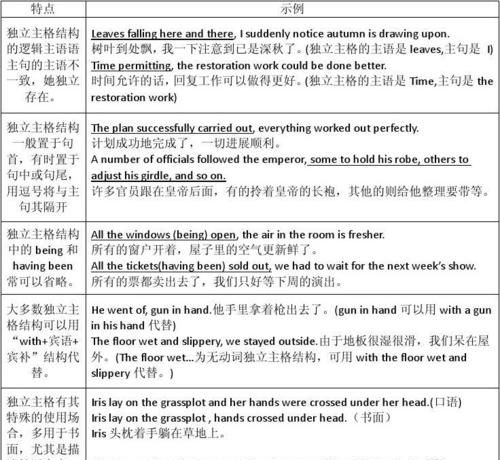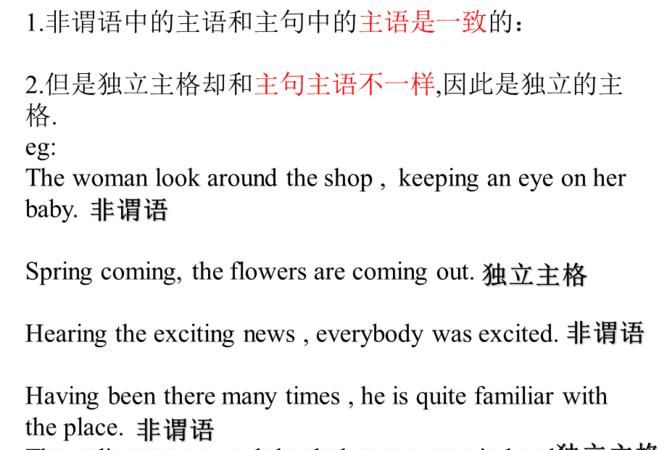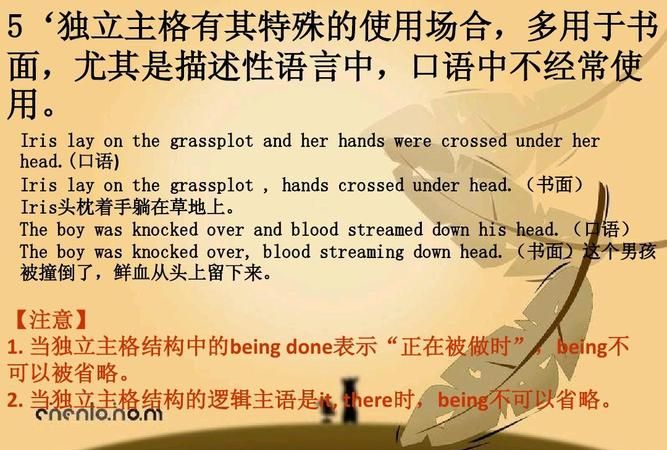本文目录
独立主格的用法总结思维导图
一般独立主格形式:与主句逻辑关系松散形式为:n.+-ed/-ing形式;n.+不定式;n.+介词短语;n.+形词;n.+副词。独立主格结构有两部分组成,前一部份是名词或者代词,后一部分是非谓语动词(不定式、动名词和分词)或形词、副词、或介词短语。
前后两部分具有逻辑主谓关系。独立主格结构在句中做状语,多用于书面语。独立主格结构本身不是句子,在句子中作状语,表示时间、原因、条件、伴随、目的等。
“独立结构”在句中起状语作用,相当于状语从句,表示时间、原因、条件、方式或伴随等情况。

英语中独立主格是什么意思
独立主格结构主要表示谓语动词发生的时间、原因、条件或伴随情况等,相当于一个状语从句或并列句。
1. 独立主结构形式可用以表时间,理由,条件,伴随状态等。
He lay on the grass, the sun shining upon him.
= He lay on the grass, and the sun was shining upon him.
Weather permitting, I'll start tomorrow.
= If weather permits, I'll start tomorrow.
School being over, the boys went home.
= When school was over, the boys went home.
The sun having set, we arrived at the station.
= After the sun had set, we arrived at the station.
王牌重点:当独立主格结构的主语表示“一般人”,如:we, one, you时,主语可省略,此用法常用于下列表达方式中:
generally speaking 一般来说
strictly speaking 严格地说
talking of ... 谈到
speaking of ... 说到
judging from ... 由……来判断
taking all things into consideration 把一切都考虑在内
considering ... 考虑到……
[示例]
If we judge from his face, he must be ill.
= Judging from his face, he must be ill.
He has lots of books if we consider that he is young.
= He has lots of books, considering that he is young.
2.with 复合结构也是独立主格结构形式之一。这种结构在句中作状语(表示原因,方式,伴随等)和定语,作定语时紧随被修饰名词后。
(1) with+ 名词 + 介词短语
The woman with a baby on her back is my sister.
The boy rushed into the room, with his schoolbag in his hand.
(2) with + 名词 + adj.
with the door open, he left the classroom.
(3) with + 名词 + adv.
With the gloves off, she felt cold.
With the lights on, the building looks beautiful.
(4) with + 名词 + 现在分词(主动)
with + 名词 + 过去分词(被动)
With the guide leading us, we got to the village.
The boy was crying with the vase broken.
(5) with + 名词 + 不定式
With the hard work to be done, we have to prepare for it.

英语独立主格是什么意思
独立主格结构是由名词或代词加上分词或分词短语构成的一种独立结构,不是一个词或词组。独立主格结构中的名词或代词与其后的分词或分词短语构成逻辑上的主谓关系。The traffic inched along,with horns honking∩_∩

英语中独立主格的用法
独立主格结构是由一个相当于主语的名词或代词加上非谓语动词、形容词(副)词、或介词短语构成的一种独立成分。该结构不是句子,也不是从句,所以它内部的动词不能考虑其时态、人称和数的变化,它与其主句之间既不能通过并列连词连接也不能有从句引导词引导,常用逗号与其主句隔开。独立主格结构在很多情况下可以转化为相应的状语从句或其他状语形式,但很多时候不能转化为分词形式,因为它内部动词的逻辑主语与主句主语不一致。在做这类题目时一定要小心判断,不能粗心大意。
一、独立主格结构的构成形式
独立主格结构的构成方式为:名词普通格或代词主格+现在分词/过去分词/不定式/名词/形容词/副词/介词短语等。使用独立主格结构是因为出现了与句子主语不一致的情况。
1. 名词或代词+现在分词
现在分词表示前面的名词或代词主动进行的动作或状态。如:
The man lay there, his hands trembling.
那个男子躺在那儿,双手在颤抖。
有时,现在分词being或having been在独立主格结构中可以省略。如:
The weather (being) fine,we decided to go swimming.
天气晴朗,我们决定去游泳。
2. 名词或代词+过去分词
过去分词表示前面的名词或代词被动完成的动作。如:
The girl sat there silent,her head bent low.
这姑娘一声不响,低着头坐在那里。
All things considered, her paper is of greater value than yours.
各方面考虑起来,她的论文比你的论文更要有价值一些。
3. 名词或代词+不定式(短语)
不定式表示将来的动作。如:
He suggested going for a picnic,Mary to provide the food.
他建议去野餐,由玛丽负责提供食物。
Time is pressing, two hours to go only.
时间紧迫,只剩两个小时了。
4. 名词或代词+名词(短语) 如:
Many people joined in the work, some of them women and children.
许多人参加了这项工作,其中一些人是妇女和儿童。
5. 名词或代词+形容词(短语)
形容词(短语)说明前面名词或代词的性质或状态。如:
The floor wet, we had to stay outside for a while.
地面很湿,我们只好在外面呆一会儿。
6. 名词或代词+副词
副词也多是说明前面名词或代词的状态。如:
The meeting over, we all went home.
会议结束了,我们都回家了。
7. 名词或代词+介词短语 如:
The teacher came in, a book in his hand.
老师进来了,手里拿着一本书。
有时,独立主格结构中名词前面的定语可以省略。如:
The boy lay silently on the grass, (his) eyes closed.
A girl was walking in the street, (a) flower in (her) hand.
二 独立主格结构的作用
1. 作状语
1) 表示时间 如:
Her homework done (=After her homework was done),Lucy decided to go shopping.
2) 表示原因 如:
There being no buses (Because there were no buses),we had to walk home.
3) 表示条件 如:
Weather permitting (If weather permits), we will go to play football.
4) 表示方式或伴随 如:
He rushed into the room, his face covered with sweat.
2. 作同位语 如:
There are two doors, one leading to the bedroom, the other (leading) to the kitchen.
三 独立主格前面有时可以加上介词with或without,构成介词的复合结构。这种结构在句中主要用作状语,也可用作定语。如:
He stood on the deck with his hand waving to us.(状语)
他站在甲板上向我们频频挥手。
He went out without a hat on his head.(状语)
他头上没戴帽子就出去了。
Do you know the girl with a bag on her back?(定语)
你认识那个后背上背包的女孩吗?

以上就是关于英语中独立主格的用法 ,独立主格的用法总结思维导图的全部内容,以及英语中独立主格的用法 的相关内容,希望能够帮到您。
